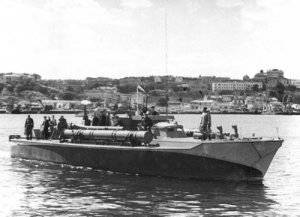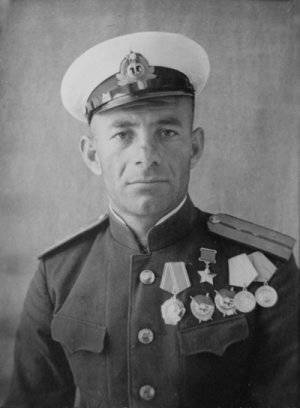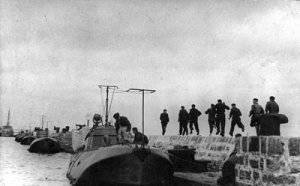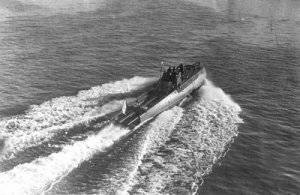Life is like a torpedo attack
 These memories bit by bit, communicating with the former fellow soldiers of the Hero of the Soviet Union, captain 3 of Kochiev Konstantin Georgievich rank, were collected by his daughter Svetlana Konstantinovna. We were handed over to the editorial staff by the first deputy chairman of the committee of the regional public organization “Association of veterans of military commissariats of the city of Moscow” captain 1 retired rank Yury Andreyevich ZAYTSEV. Kaperang, himself a boatman in the past, said about Kochiev: “We called him a boat Marinesko”.
These memories bit by bit, communicating with the former fellow soldiers of the Hero of the Soviet Union, captain 3 of Kochiev Konstantin Georgievich rank, were collected by his daughter Svetlana Konstantinovna. We were handed over to the editorial staff by the first deputy chairman of the committee of the regional public organization “Association of veterans of military commissariats of the city of Moscow” captain 1 retired rank Yury Andreyevich ZAYTSEV. Kaperang, himself a boatman in the past, said about Kochiev: “We called him a boat Marinesko”.A gift of fate
 In June, 1933, Kosta Kochiev, an 20-year-old boy from the mountain village of Tontobet in South Ossetia, became a cadet of the MV Higher Naval Command School. Frunze in a huge and beautiful Leningrad.
In June, 1933, Kosta Kochiev, an 20-year-old boy from the mountain village of Tontobet in South Ossetia, became a cadet of the MV Higher Naval Command School. Frunze in a huge and beautiful Leningrad.In a personal matter, they will later write that it was at the call of the Komsomol that he was sent to serve in the Navy, that, according to the order of the military registration and enlistment office of Tskhinval, he went to take exams at the Leningrad VVMKU.
And it can be said in another way: it is fate itself, which is rarely generous, showed him the only way where a person finds his vocation. He lived all 33 of the year, but he lived them like a hero in attack.
After all, he could serve in the infantry or in the army to learn to be a chauffeur, he could work all his life as a mechanic, whom he had learned at a factory school in Tbilisi. Or do some other business. There is no doubt that he and there everything would go well. Kostia was distinguished by his hardworking since childhood, he was strong and brave: he was engaged in wrestling and a barbell, always defended justice. And although he was laconic, he studied well. Complicated naval technology and artillery science studied, mastered the tricks of astronomy and sailing. That is, of course, he would be in any case a worthy man and a citizen of his country. Another thing - what he became!
A mountaineer Kosta Kochiev became a brilliant naval officer, a distinguished combat commander of torpedo boats, a hero of a great country.
Naval cavalry
Graduated with honors from the Higher Naval School. He was sent to the Black Sea Fleet, was appointed commander of a torpedo boat, and from 1939 of the year - a detachment of torpedo boats of the 1 brigade. Torpedo boats with 40 – 45 speed knots were then called naval cavalry.
From the first months of service, the command instructed Kochiev, appreciating his interest and knowledge of technology, to test the latest technology - to identify its strengths and weaknesses, find hidden resources, give engineers practical recommendations on improvement, and on application - to other teams. And then he, the detachment commander, had to deal with this in a combat situation. For example, Kochiyev tested the American boat “Voper”, katyusha jet mortars, which needed to be adapted and mastered for effective use on torpedo boats.
Of course, all military equipment came with documentation and instructions - the rules for working on them. But Costa was an innovator by nature, did not recognize the patterns, he always went beyond the instructions, because the war required it. Deep and solid military knowledge gave Kochiev the right to be creative when performing the most difficult combat missions. So it was not by courage alone that he tore out his victories from the enemy.
This is confirmed by the respectful title of “academician”, which with the light hand of the renowned motorboat of the Hero of the Soviet Union, Ivan Sheng, was fixed to Kochiev. In the transient sea battles, where everything depends on the commander, on his resourcefulness, decisiveness, ability to assess the situation, Costa Kochiev was in fact the “maestro of the blitz”.
Since 22 June until the end of August 1941-of boats under the command of Kochieva went to the exploration and the landing, escorted transports and escorted warships carrying patrols, covered minesweepers, saved our downed pilots and captivated enemy pilots, mined enemy fairways, made daring raids and delivered torpedo attacks on the coastal fortifications of Romania, an ally of Nazi Germany. The young “academician” commander Kochiev made advanced proposals to many methods of accomplishing combat missions, and invented, developed and implemented some of the techniques. So it was, for example, with the cleaning of our fairways from German mines.
Minigame
 From the first week of the war, contact mines became an acute problem, with which fascists threw Black Sea ports from planes, causing heavy damage to our ships and blocking the exits from ports. To solve this problem, the commander of the Black Sea fleet Vice Admiral F.S. Oktyabrsky gathered officers from torpedo boat units.
From the first week of the war, contact mines became an acute problem, with which fascists threw Black Sea ports from planes, causing heavy damage to our ships and blocking the exits from ports. To solve this problem, the commander of the Black Sea fleet Vice Admiral F.S. Oktyabrsky gathered officers from torpedo boat units. There were no special innovative proposals, but when Kochiev suggested to undermine mines by dropping depth charges from a fast-moving boat, some co-workers considered this to be frivolous and even self-inflicted. However, Oktyabrsky himself was a boatman, and therefore instructed Kochiev to conduct an experiment on the Inkerman gauge, taking three old boats.
And Senior Lieutenant Kochiyev proved that it is possible to use this method for cleaning the fairways of German mines. Of course, with the risk - but because the war! Kochiev co-worker Hero of the Soviet Union A.E. Chertsov recalled: “Not only here, but also in other fleets, the boatmen studied his audacious operations, adopted his experience. He was the first to pass over enemy mines lying at the bottom of the Sevastopol fairway, so that the noise of his propellers, the shadow of the hull and the depth charges dropped from the boat by detonating mines, blowing them up and clearing the way for our ships. The priority of such a "trawling" of enemy mines, of course, belongs to him and only to him - Konstantin Kochiev, who made the "first flight over death" successfully. The success was facilitated by an inquisitive analysis of a professional, the courage of the “horseman of the marine cavalry”!
Ochakov's sections
 Hero of the Soviet Union G.A. Rogachevsky recalled: “After our troops left Ochakiv at the end of August 1941, the enemy moved along the Black Sea coast, it was necessary to block the exit from the Dnepr-Bugsky estuary in order to prevent enemy shipping here. This task was assigned to our 1 Brigade (torpedo boats. - Ed.) In September of 1941 ... Head of the link, as well as during the bombing exercises, experienced commander of the 2 division of the 3 division I, Lieutenant Kochiev K. G. "
Hero of the Soviet Union G.A. Rogachevsky recalled: “After our troops left Ochakiv at the end of August 1941, the enemy moved along the Black Sea coast, it was necessary to block the exit from the Dnepr-Bugsky estuary in order to prevent enemy shipping here. This task was assigned to our 1 Brigade (torpedo boats. - Ed.) In September of 1941 ... Head of the link, as well as during the bombing exercises, experienced commander of the 2 division of the 3 division I, Lieutenant Kochiev K. G. "September 27 3 minutes 40 successfully carried out the laying of mines at the Ochakov Terrain Block in the Kinburn Spit area. This important fact of mine has been noted in “Stories torpedo boats during the Great Patriotic War ". The threat of undermining ships in the line constantly kept the Germans and their allies in suspense.
When entering combat missions, Kochiev always chose a boat with a less experienced commander. His method - “to teach in battle” - helped the young officers to quickly form because Kochiev ruled out petty care, gave greater autonomy in making tactical decisions, and with his respect for the personality of the subordinate, Costa educated him to be ready to take full command responsibility. .
Heading to Yalta
The “raids” of torpedo boats on enemy-occupied ports became a priority at the start of 1942. The first of these campaigns was carried out on the night from 8 to 9 in January in Yalta occupied by the enemy. By this time, the Germans based their torpedo boats and submarines in Yalta, operating on our communications Sevastopol - Novorossiysk. The hike was unsuccessful: torpedoes with TKA-101 and TKA-121 "did not go," the vehicles failed, nothing was fired by artillery firing at the Yalta port of our two "sea hunters" from this squad.
Received an order to repeat the raid. Hope was on the boat D-3. This time the exit was headed by the commander of the detachment, Lieutenant Commander Kochiev. It was taken into account a lot. TKA took extra fuel. For a stable connection, as a repeater, in the area of Cape Meganom, between Theodosia and Sudak, TI-52 A.I. was nominated. Kudersky, the future Hero of the Soviet Union.
The direct participant in the operation, the torpedo boat Georgy Gavrish, recalled that according to the plan, on the night of June 13 of the year, Yalta had to come under cover of darkness to 1942 hours of the night. But late tankers were detained in Anapa.
There was a lot of fuel needed - to Yalta and back. In the fuel tank compartment, the boat could only take 3,5 tons, but it was necessary to about 5 tons. I had to load 12 drums on 200 liters onto deck.
Hastily taking the fuel, the boat went to sea. One thing was comforting that the weather was great. Were going a good move, 30 - 32 node. As fuel was consumed, they pumped gas into regular tanks, and empty barrels were filled with seawater to prevent gasoline vapors from the enemy projectile. Because of the delay in Anapa, they came to Yalta when the sun rose.
Approached Yalta at low speeds. The enemy on the shore did not show any signs of concern: the Germans could not have expected such impudence! But there was also the expectation that the D-3 was one and very different from the other torpedo boats, the Nazis knew little about it. In addition, his silhouette greatly changed the barrels on board.
A naval flag was flying on a boat. So we went straight to the port. Kochiyev all the time carefully examined the port through binoculars. From time to time it will push the boat with motors and again stop it. Amazing shutter speed! And only having stepped aboard the speedboat amphibious assault ship loaded with military equipment, Kochiev gave the command to attack.
“... The torpedo noisily flies out of the vehicle and plops into the water, raising splashes,” recalled a participant in that raid. - On the smooth surface of the sea appeared a clear whitish mark - the torpedo went. Right on target! And Kochiev is again imperturbable: he is standing and looking. And only when the torpedo plunged into the barge, raising a huge column of fire and smoke, Kochiev gives the engines full gas and abruptly commands: “Smoke!” The engines roared, the boat pulled forward, the smoke curtain reaching behind us. The shore opened a fierce fire: they beat guns, machine guns and even mortars. Around the boat, the water literally boils from ruptures. With a roll on the right side - after all, the torpedo is in the apparatus, - hiding from the smoke, we hide from the shelling and safely arrive in Novorossiysk. ”
Soon, Kochiev, with two D-3 boats and an experimental CM-3, repeated the raid on Yalta, even more daring. And although two sailors were killed in the battle and another died from wounds in the hospital, the enemy paid more: the boat crew torpedoed a German submarine, two landing barges, and coastal fortifications.
One raid - five wins
The most successful attack of torpedo boats is also associated with the name of KG Kochiev. In the evening of 31 on June 1942, aerial reconnaissance discovered five enemy high-speed landing barges in Dvuyakornaya Bay, south of Theodosia. In the twilight, the captain-lieutenant KG led his long-range torpedo boats to the next raid. Kochiev. Arriving in the area of Feodosia Bay, they turned on mufflers and penetrated the bay at low speed. Three torpedo salvoes alternately rang out at three anchor barges.
After the explosions of the barges, the enemy turned on the searchlights and opened anti-aircraft fire. But there was no one in the sky. Searchlights zasharili on the bay, and only then the Germans found the boat and moved the fire on them.
But Kochiev’s torpedo boats didn’t keep silent: shortly before the march, naval "Katyushas" mounted them. Kaperniki fired on the Nazis two volleys with missiles and finished off the remaining enemy barges, and got the Germans on the shore. And the boats returned to their base without losses.
Battle of Novorossiysk
The start of 1943 for the Black Sea was a very difficult test, and the role of torpedo boats in it was exceptional. In February, a landing force commanded by Major Caesar Kunikov was landed in Tsemes Bay. This landing in the area of Stanichka (it will be called Minor Land) played a huge role in the preparations for the liberation of the port city. For seven months, brave warriors kept this piece of land under the round-the-clock lead rain. And all these long months from the sea, paratroopers defended, delivered to the Little Land weapon, reinforcements and food, took out the wounded crews of torpedo boats. This hard work had to be done mostly at night.
When the headquarters of the Black Sea Fleet was developing an operation to storm Novorossiysk, the main question was: where and with what resources did the landing force land? They made a bold decision - to use torpedo boats as a kind of ram to break through barriers and destroy the mole by torpedoes. And the boatmen fulfilled their duty with honor.
After the release of Novorossiysk on the orders of the People's Commissar of the Navy, Admiral N. G. Kuznetsov, all the ships of the Black Sea Fleet, including the battleship and cruisers, were to meet with the combat boats that participated in the liberation of Novorossiysk, pay tribute to the sailors - to build personnel and play "Huddle". The sailors of these ships, who were on the deck and superstructures, must assume the position “at attention”, the admirals, officers and chief officers - put a hand to the headgear.
This honor in the fleets is given only in the most exceptional cases. And this honor, along with his subordinates and combat colleagues was awarded the captain of 3 rank Konstantin Kochiev.
Liberation of Sevastopol
 On the night of 5 in May 1944, Kochiev went to Cape Chersonesus with four boats, where a caravan of German ships escorted minersweepers, landing barges and boats. Kochievtsy rushed to the attack, made their way through the living veil and torpedo attacks sank two vehicles and barges.
On the night of 5 in May 1944, Kochiev went to Cape Chersonesus with four boats, where a caravan of German ships escorted minersweepers, landing barges and boats. Kochievtsy rushed to the attack, made their way through the living veil and torpedo attacks sank two vehicles and barges.A few days later Kochiev again took the boat to Sevastopol, destroyed the next caravan of enemy ships, which lost about two thousand soldiers and officers. Under the leadership of the commander of the detachment Kochiev Viktor Sukhorukov drowns German transport with a displacement of 3 thousand tons, Leonid Kelin - 2 thousand tons, Vasily Beloborody - 2 thousand tons.
9 May 1944 th lieutenant Andrei Chertsov sent two high-speed landing barges to the bottom. 11 in May, it also drowns thousands of tons of 4 transport and, together with Ivan Opushnev, two high-speed landing barges. Sevastopol is ours! All of these battles took place under the direction of Kochiev, the commander of the 3 captain's rank.
The Germans were so angry at him that their intelligence made several attempts to destroy Konstantin Georgievich - this was stated by Hero of the Soviet Union Yaroslav Iosseliani in his book “Caution! Kochiev ahead! ”
By decree of the Presidium of the Supreme Soviet of the USSR from 16 of May 1944, the commander of the torpedo boat squadron K.G. Kochiev was awarded the title Hero of the Soviet Union. In the 1 th brigade of torpedo boats of this high rank, Kananadze A.G., Kotov S.N., Kudersky A.I., Rogachevsky G.A., Chertsov A.E. were also awarded this rank. And the whole team was awarded the title of "Sevastopol."
Order: live to Victory!
In the winter of 1943 of the year, during the Kerch-Eltigen landing operation, Kochiev's boat hit a mine and began to dive quickly. The whole staff was in cold water. All managed to be saved, but because of the long stay in the icy water, Kochiev’s mighty health was undermined. He hid it and another one and a half years, until the end of 1944, remained in the ranks, performing as before the most dangerous and audacious military operations. A total of 256 operations were in his combat account.
During the Great Patriotic War, air reconnaissance and attack aircraft for 100 successful combat missions honored the title of Hero of the Soviet Union. True, rarely any of them succeeded. Well, to whom the fate smiled - they received the Gold "Stars". According to such calculations, the launching boat Kosta Kochiev has fulfilled the heroic norm 2,5 times.
In December 1944, Kochiev’s illness forced him to go to the Sevastopol hospital. Here he was visited by the people's commissar of the Navy, Admiral N.G. Kuznetsov. He told Kochiev that he was enrolled in the lists of participants in the upcoming Victory Parade on Red Square and should be treated as vigorously as he fought.
But time to cure, unfortunately, was lost, medicine was powerless. October 8 1946 Konstantin Georgievich was gone.
Streets in Sevastopol, Tskhinval and Java, Tskhinvali school number 3 are named after the famous Soviet boat.
That's what torpedo GF wrote about his legendary commander. Gavrish: “Konstantin Georgievich Kochiev was a highly modest man. He did not like very much if he was called the Hero of the Soviet Union. He said: “You are all heroes, and I received this high rank as your commander” ... He was Ossetian by nationality, and I was so filled with love for him that even now, many years later, this love extends to all Ossetians. Once a Ossetian man, it means that he is the same as our Kochiev! Naive, of course, but it is so ... "
Information